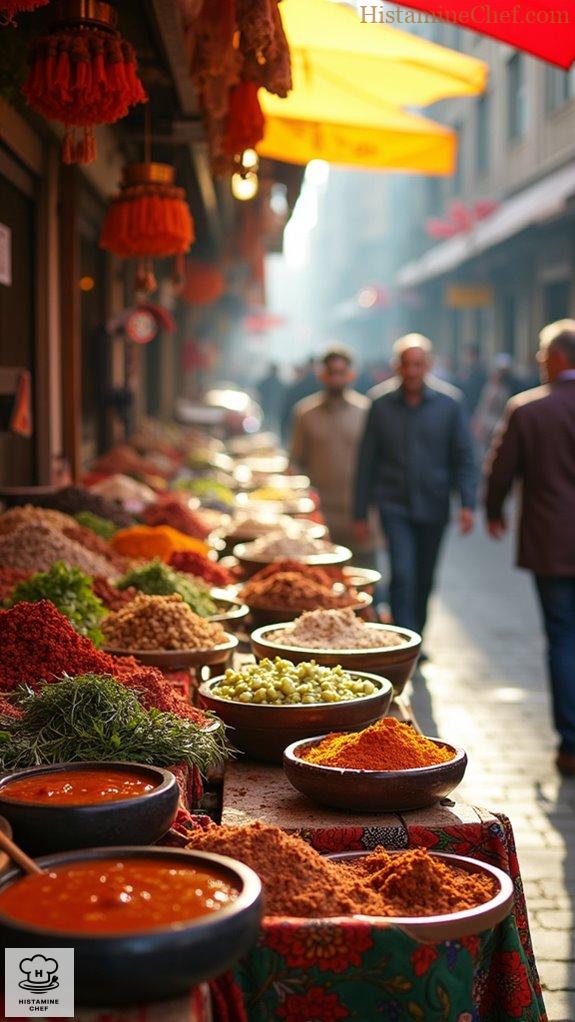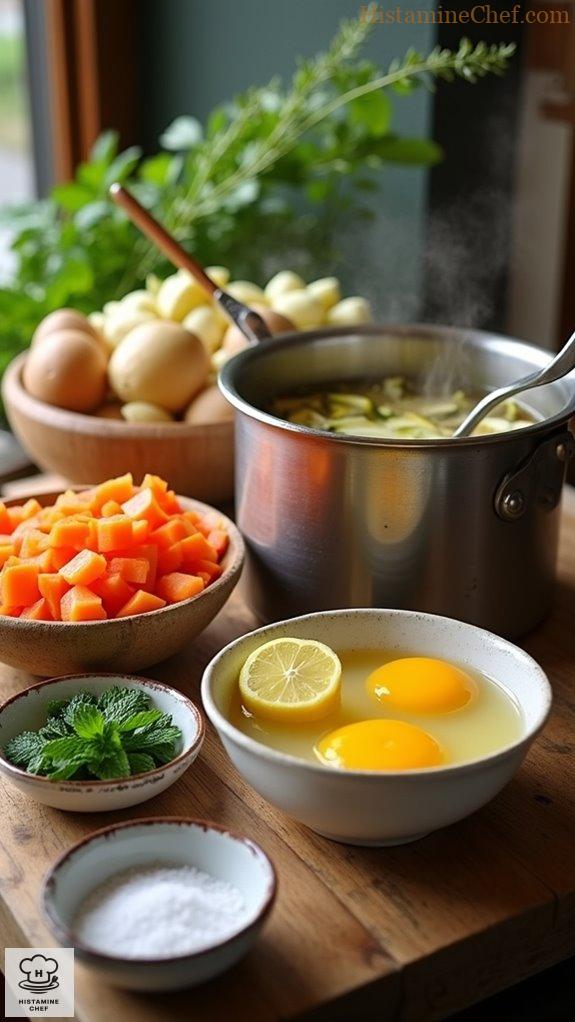If you want to whip up a low-histamine Iranian soup, I’ve got just the recipe for you! Start by boiling water in a large pot, then toss in fresh meats like chicken and let that savory broth develop. Instead of traditional legumes, try rice noodles for a fun twist! Add fresh herbs like mint and parsley, avoiding the usual high-histamine culprits like onions. Curious how it all comes together? Stick around, and I’ll share more delightful secrets!
Bustling Streets of Tehran

Tehran’s bustling streets are alive with the enticing aromas of street food, which play a crucial role in the city’s vibrant culture and daily life. Small vendors and food stalls line the busy thoroughfares, offering a variety of traditional Iranian dishes, such as kebabs, dizi (a hearty lamb and bean stew), and fresh bread.
The history of street food in Iran is deeply rooted, tracing back centuries when merchants would sell ready-to-eat meals to travelers and workers in bustling bazaars. Today, this culinary heritage thrives amid Tehran’s urban surroundings, where street food serves not only as a quick and affordable meal option but also as a social gathering point. Interestingly, the city’s current population figures reflect the increasing demand for diverse food options that cater to its growing urban agglomeration.
Locals and tourists alike flock to popular spots like Tajrish and Jannat Abad, experiencing a rich tapestry of flavors that reflect both regional ingredients and modern influences. The lively atmosphere is punctuated by the sounds of sizzling grills and the chatter of people, illustrating how street food in Tehran is an essential aspect of the city’s communal life, fostering connections among diverse communities while celebrating the rich culinary traditions of Iran.
Street Vendors Boiling Large Pots

Street vendors making Iranian soup begin by vigorously boiling water in large aluminum or stainless steel pots, utilizing portable LPG burners to maintain high and consistent heat.
They first add pre-soaked meats, such as chicken or beef, to create a savory broth, followed by spices like turmeric and salt for deeper flavor infusion.
After allowing the meats to simmer, they gradually introduce herbs and noodles, ensuring fresh herbs are added towards the end to enhance the aroma.
Throughout the cooking process, vendors intermittently stir the pot and cover it to retain heat and speed up boiling, while keeping an eye on broth levels and maintaining cleanliness to avoid contamination.
Ingredients Needed:
- 1 kg chicken or beef (cut into pieces)
- 200 g noodles (flat or thin)
- 100 g fresh parsley (chopped)
- 100 g fresh cilantro (chopped)
- 2 tablespoons turmeric
- 1 tablespoon salt
- 500 g beans or legumes (pre-soaked)
- 3 liters water
Cooking Steps:
- Boil water in large pot.
- Add meat pieces to boiling water.
- Stir in turmeric and salt.
- Simmer meat until tender.
- Add beans/legumes for cooking.
- Introduce noodles and herbs later.
- Adjust heat to prevent burning.
- Ladle soup into serving containers.
Prepare Ingredients From SIGHI List

To make Iranian soup at home while adhering to the SIGHI list, use allowed vegetables like carrots, potatoes, and zucchini, and incorporate allowed herbs such as mint and parsley for flavor.
Bone broth can be a great base to enhance the soup’s richness. Use egg yolks to add creaminess instead of traditional dairy products.
Keep spices simple; avoid restricted items like cumin or chili. Instead, season with salt, mint, and a squeeze of lemon juice if tolerated.
Simmer all ingredients until tender, and adjust seasoning to taste for an authentic yet safe dish.
Changes for Cooking at Home:
- Replace traditional broth with homemade bone broth
- Use allowed vegetables: carrots, potatoes, zucchini
- Avoid restricted spices: no cumin, no chili
- Incorporate fresh herbs: mint and parsley
- Substitute cream with egg yolks
- Adjust seasoning: use salt and lemon juice
- Simmer until veggies are tender
Low Histamine Variation of Ash Reshteh

Street food often contains ingredients that are high in histamine and liberators, making them unsuitable for individuals with histamine intolerance. Commonly, processed meats, fermented products, and certain vegetables are prevalent in street food offerings, leading to potential adverse reactions. As a result, those affected by histamine intolerance may struggle to find safe and enjoyable options in these environments.
Eating street food like Iranian Soup (Ash Reshteh) can be problematic for individuals with histamine intolerance due to the presence of restricted ingredients such as legumes, certain spices, and processed items. The SIGHI list identifies these ingredients, such as beans and fermented dairy, which can trigger symptoms like headaches and digestive issues.
Moreover, street food preparation often involves high-histamine ingredients and practices resulting in further histamine liberation, exacerbating intolerance symptoms. Simple cooking techniques such as using fresh ingredients and avoiding long storage times can help mitigate these risks.
To prepare a low histamine variation of Iranian Soup (Ash Reshteh) at home, follow these steps:
- Replace traditional legumes with allowed ingredients like rice noodles.
- Use fresh herbs (parsley, mint) instead of any restricted spices or seasonings.
- Opt for fresh vegetables only, avoiding onions, tomatoes, and spinach.
- Substitute regular broth with homemade, non-processed stock without high-histamine ingredients.
- Choose fresh meats such as chicken or turkey instead of any processed meats.
- Avoid adding any kind of vinegar or soy sauce in the recipe.
- Use olive oil instead of any restricted oils for sautéing.
- Eliminate any tinned or canned ingredients and focus on fresh produce.
- Don’t include any dairy; use almond or coconut milk instead if creamy texture is desired.
- Cook all ingredients promptly to avoid histamine buildup during extended storage.
Video Summary
Iranian soup, known as “Ash-e Reshteh,” has a rich history rooted in Persian culture. This traditional dish symbolizes nourishment and hospitality.
In this video, we’ll explore the authentic street version and a home-friendly, low histamine alternative.
Street vendors start with a large pot. They add water and bring it to a boil.
Next, they toss in fresh herbs like parsley, cilantro, and mint. Onions are sautéed until golden in olive oil. They then add noodles called “reshteh” along with various legumes, including kidney beans and chickpeas. Garlic gives an aromatic touch, while spices such as turmeric and black pepper enrich the flavor.
After simmering, they top it with crispy fried onions and a dollop of yogurt.
For the home low histamine version, we’ll skip the chickpeas. Substitute kidney beans for a milder taste.
Instead of onions, use leeks for subtle sweetness. Replace spices like black pepper with approved herbs for flavor. Avoid store-bought yogurt; instead, use fresh goat’s milk yogurt as a safer option.
The cooking tool remains the same: a sturdy pot. Begin with water in the pot, then add fresh herbs.
Sauté leeks in olive oil until translucent. Incorporate the water for boiling beans. Add the noodles and let everything simmer together.
Finally, garnish with the goat’s milk yogurt for creaminess.
The final soup is vibrant and fragrant, offering a delightful fusion of flavors. For the full recipe, click the link in the description. Enjoy cooking!
References
- https://worldpopulationreview.com/cities/iran/tehran
- http://mit.edu/~ecprice/Public/freq/googlelist.counts
- https://www.youtube.com/watch?v=XmZyGEdeXGo
- https://www.lingexp.uni-tuebingen.de/z2/Morphology/baroni.rows
- https://www.tehrantimes.com/news/501887/Data-drives-Tehran-a-smarter-future-for-the-capital
- https://labsalliebe.com/en/persian-vermicelli-soup/
- https://soupchick.com/iranian-soup-recipe/
- https://theunmanlychef.com/2015/09/23/ash-persian-herb-bean-and-noodle-soup/
- https://cookingwithayeh.com/ash-reshteh-persian-noodle-and-herb-soup/


Leave a Reply